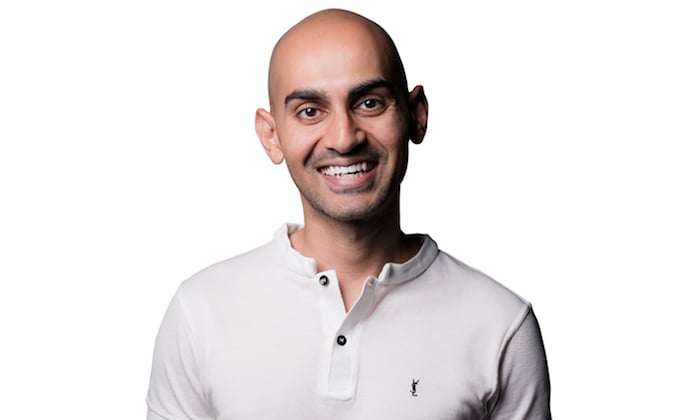Transcript of Becoming a Great Leader, No Matter What Field You’re In written by John Jantsch read more at Duct Tape Marketing
Back to Podcast
Transcript
This transcript is sponsored by our transcript partner – Rev – Get $10 off your first order
John Jantsch: Leadership is leadership. Doesn’t matter what role you’re in, if you’re running a company, if you’re an elected official. In this episode of the Duct Tape Marketing Podcast, I visit with Jason Kander. We talk about his book, Outside the Wire, getting outside your comfort zone to learn the lessons of leadership. Check it out.
 Stuff like payroll and benefits are hard. That’s why I switched to Gusto, and to help support the show, Gusto is offering our listeners an exclusive, limited-time deal. You sign up for their payroll service today, you’ll get three months free once you run your first payroll. Just go to Gusto.com/tape.
Stuff like payroll and benefits are hard. That’s why I switched to Gusto, and to help support the show, Gusto is offering our listeners an exclusive, limited-time deal. You sign up for their payroll service today, you’ll get three months free once you run your first payroll. Just go to Gusto.com/tape.
Hello, and welcome to another episode of the Duct Tape Marketing podcast. This is John Jantsch and my guest today is Jason Kander. He is husband, father, former Army captain who served in Afghanistan. He is also Missouri’s former Secretary of State, and the president of an organization called Let America Vote. He is also a candidate for the mayor of Kansas City, Missouri, and we’re gonna talk about his book called Outside the Wire: Ten Lessons I’ve Learned in Every Day Courage. Jason, thanks for joining me.
Jason Kander: Thanks for having me.
John Jantsch: So, I’ve had a lot of authors, thousands of authors I’ve interviewed and I don’t think I’ve had one that has written a political biography yet on the show, so this is a first, but in reading your book, which I really loved, there’s so many lessons in there that are really leadership lessons in the truest sense, and I think entrepreneurs in the truest sense, the successful ones anyway, are leaders at heart, so I want to unpack the book really in that vein, if that makes sense.
Jason Kander: Yeah, it makes sense to me. Thanks.
John Jantsch: Let me start with the title, “Outside the Wire.” In kind of common military jargon, that’s sort of the idea of being beyond the safe base camp area, so how does that metaphor really kind of set the subtext for the book?
Jason Kander: Well, for me, the experience of going outside the wire in Afghanistan, going like you said, off the safety of the base, that’s an event in my life that a lot of times I kind of think about my life I guess as before and after that moment, and I think that’s true for a lot of people who have experienced anything like that, anything that can be just scary to do and forces you to get literally outside your comfort zone. At the same time, the book is mostly about … I mean there are stories in the book as you saw and lessons in the book, from my time in the military and specifically from my time in Afghanistan, but mostly what it’s about is my time going figuratively outside the wire in politics, going out and taking positions that may or may not have been unpopular, may or may not have been what I was advised to say but it’s what I believed, and so really the book is just about the idea that if you want to create change, if you want to get anything done, you’re never gonna do it from within your comfort zone, either literally or figuratively.
John Jantsch: There’s … and I don’t know if you’ll be able to do this, I’ve written a number of books and sometimes I’ll be interviewed, and they’ll say, “You know, you were telling that one story,” and I’m like, “Gosh, I wrote that a while ago. I don’t know if I remember that.”
Jason Kander: I’ve only written one book, so don’t worry, and it wasn’t that long ago so I’m probably gonna be able to get it.
John Jantsch: Awesome. Well, I’m gonna try to set it up and then you tell the story, because one of the really great things about why the book works so well for me is you’re a really good story teller and I’d love to have people hear the story part, so there’s one of the early lessons that you basically said you went out and kind of failed at this training thing, and you thought you were gonna get really taken to task over it, but it went a different way when you actually met with the sergeant. The lesson in that was really that here’s how real tough guys act, and I think that there are a lot of leaders and companies that feel like they have to be the authoritarian, dress everybody down, use fear in some cases, as a leadership tool. I wonder if you’ve … hopefully I’ve jogged your memory enough to know that story I was talking about.
Jason Kander: Yeah, absolutely. One of the lessons … the book’s organized into lessons which are just the chapter titles, and one of the lessons is experience is good, but perspective is golden, and that’s one of the early stories in that lesson. What happened was I was pretty new to the Army, I was an Army ROTC and we were doing land navigation training and we were doing nighttime land navigation training, which means that I was out in the woods, pitch dark in pretty heavy woods at an Army base and I had a compass and a protractor and a map and I was supposed to find these very difficult to find points, which are just like little sticks that stick up in the woods. They have little numbers on them and you’re supposed to write them down on your card to prove that you could navigate to these points. It was pouring rain. It was pretty quickly evident that I wasn’t doing well at this, it was my first time doing it at night. My map disintegrated in the rain. It was just a bad scene and it was a low morale moment, so to speak.
What the context of this is that that weekend out in the woods, we had with us an instructor who had only been with us this one time and he was this guy, Master Sergeant Matt Eversmann, and while most people listening to this will have no idea who that is, a lot of people actually have seen him portrayed on the big screen by Josh Hartnett in a movie called Black Hawk Down. The main character in that movie, it’s based on a true story, and the main character in that movie is Matt Eversmann, who at the time was a very young sergeant, and now by the time that I met him, he’s this Master Sergeant with a lot of combat experience and this was pretty soon after 9/11 that I had joined, so at that point very few people had deployed, so he was very unique. Now, somebody with that level of experience would be a lot less unique, still commendable, but a lot less unique. At that time, he was like … we were all like, “Oh my god. That’s Matt Eversmann.”
So I’m scared to death because I’m going back to turn in my score card which has nothing on it. I actually didn’t know whether I’d see him. I was just expecting, okay, some sergeant’s gonna get up in my face and tell me how awful it is that I got lost and how if I got lost in combat while I was commanding troops everybody would die, so I just figured, “Okay, I’m about to be humiliated. That’s fine. I’m soaking wet. I just want to change into dry underwear. Whatever.”
So I’m in line, I get to the front and I realize it’s Master Sergeant Matt Eversmann who I have to turn my card into and then I’m just feeling humiliated because I figure all he’s about to know about Cadet Kander is that he sucks at land nav, and that seemed mortifying. So I get up to the front of the line and he looks down at me and he says, “How’d you do, Cadet?” I said, “Not well, Sergeant. I got zero points.” I’m bracing myself. He says, “Well, you still got your weapon.” I had it over my shoulder. I said, “Yes, Sergeant.” And he slaps me on the back and he says, “Success. Get in here. It’s freezing out there. We got coffee in here.”
So I get in there and some officer comes in, a lieutenant comes in, and is demanding to know why a bunch of cadets have been given hot chocolate and coffee and Master Sergeant Eversmann pipes up and he says, “I did it, sir.” He says, “You don’t have to train a soldier how to be miserable, they already know.” Of course, given his level of experience, the officer had nothing to say to Master Sergeant Eversmann about that.
For me, the lesson was a guy like Sergeant Eversmann with what he had seen and done, he had no desire whatsoever, no need to feel that he had to prove himself to any of us, and he had the perspective to understand that we all knew that if we didn’t get any points to turn in that we knew we screwed up and we were soaking wet and we were freezing, but there was no learning point in being hard on us, and in fact I think the learning point he decided to teach us was you gotta care about your people, and you don’t gotta prove yourself, because that’s what it is to be a real tough guy is to not have to show anybody.
John Jantsch: Yeah, and you obviously learned and probably grew in your respect far more than him getting in your face, as you said, would have ever done.
Jason Kander: Yeah, absolutely.
John Jantsch: I think that’s a true, again, going back to entrepreneurs, I think that is a true leadership lesson. Part of it is reading the situation, but also clearly taking care of your people is a big part of what you have to do in a company.
So, there are a lot of lines where you have bolded them or put them in bigger text, and they just really jump out inside the chapters. There’s one that I think applies to so much of what we’re experiencing today I think, and it is “Your dignity, unlike your integrity, is negotiable.” I think that’s a lesson then, I don’t know if you have a story that I can bring forward with that, but I think that’s a lesson that, boy, integrity seems to be hard to find in a lot of corners today.
Jason Kander: Yeah. What I was trying to get across there is that there’s a lot of people who when they run for office or as entrepreneurs when they start going out to pitch or … and I think this is particularly true by the way both of politicians and entrepreneurs who have been in an environment where, maybe it’s a corporate environment where they were successful and they had a lot of help around them, and they didn’t really find themselves in a position where they had to ask for things and had to put themselves out there, that they frequently will … it feels like they are mistaking dignity and integrity for being the same thing when they’re not. You should never compromise your integrity under any circumstances. I make that point several times in the book, but I also make the point that it ain’t the same thing as dignity.
One of the stories I tell in the book is about when I was Secretary of State of Missouri and I had to go into the office of a state legislator who controlled the purse strings of our office, who chaired the committee on appropriations that decided whether we had the resources to do the important work that we were doing, and there were many things about that experience, and I’ll let people read the book, there’s some funny parts to that where it’s pretty demeaning, but nothing about it is compromising my integrity, it’s just … it’s a little demeaning and so it compromises my dignity, but that should be completely worth it. I should be … if it is a good cause, if it doesn’t compromise my integrity at all, I should be more than willing to cash in any level of personal dignity to do the right thing for somebody else. It doesn’t hurt me at all to do that.
Another place where I talk about that a lot is I’m pretty open in the book about what it’s like to have to go around the country and fund raise for a competitive United States senate campaign, and just one of the things I talk about is dragging my little rolling suitcase behind me everywhere I go all the time and how I always wanted to just plop it up on the table at the beginning of a meeting and say something like, “Wait until you see these vacuums.” Because I just felt like a traveling salesperson, but I believed in the mission and I never would have compromised my integrity to raise money, but look, it’s not always the most dignified process. You gotta get over that.
That’s what I see new candidates for office struggle with a lot. When they tell me things like, “I think I could do all of it. I’m really good at all of this, but I’m not very … I’m not sure I could do the fundraising.” I always tell them, “Why not? It’s just staying on the phone. That’s all it is. It’s just being willing to be dogged.” They’re like, “Well, asking people for money.” I’m like, “Well, you should never ever compromise your integrity. You should never do anything for a contribution, but that’s how our system works right now until we change it. If you want to do the right thing for people, you’re probably gonna have to go out there and do the work that it takes to win your campaign.”
John Jantsch: Wouldn’t it be great if in your business all you had to do was the stuff you love, the reason you started the business and not all that administrative stuff like payroll and benefits? That stuff’s hard, especially when you’re a small business. Now, I’ve been delegating my payroll for years to one of those big, corporate companies and I always felt like a little tiny fish, but now there is a much better way. I switched over to Gusto and it is making payroll and benefits and HR easy for the modern small business. You no longer have to be a big company to get great technology, great benefits, and great service to take care of your team.
To help support the show, Gusto is offering our listeners an exclusive limited-time deal. If you sign up today, you’ll get three months free once you run your first payroll. Just go to Gusto.com/tape.
I don’t know if I’ve ever gone to the back cover of a book and read one of the blurbs, but I want to do this one because I think it’s … it works. “After reading this book, I concluded Jason Kander is too funny and too smart to be in politics. His motives are suspect and he should be removed from public service immediately,” Jimmy Kimmel. Where did that come from?
Jason Kander: It was very nice of him. I know Jimmy through a mutual friend and got to know him a little bit and asked him to read the book and he did and I guess it made him laugh, which made me feel really good about the book to be honest. That was a big compliment coming from him.
John Jantsch: That’s awesome. I want to dive into another one of those things that jumped out at me, and again, I think a lot of business owners, they get so, “Here’s our idea. We’re going this way. Who’s with me? We’ll never quit,” and at some point somebody has to tell them, “You know, you might be wrong about this idea.” I think that admitting that you might be wrong and that doesn’t mean giving up on your dream, but not always having to be right is an amazing leadership lesson. How did that … hopefully I again jogged your memory again on the point you were trying to make there, but that one really stood out to me.
Jason Kander: Yeah. There’s a few different stories in the book about that and it definitely is relevant … before I get into the story, it’s definitely relevant to entrepreneurs. I have not been an entrepreneur but as you know, I’m married to one, and Diana now, my wife, does a lot of innovation consultant work, and it’s always interesting to either overhear or to hear about her conversations with entrepreneurs who are just sure that they have a billion dollar idea, and when someone questions it, not in a mean way, but just the way entrepreneurs need, just sort of, “Oh, have you thought about this?”, the ones who are gonna be successful are the ones who don’t take that questioning as “I just need to convince you,” but instead are the ones who are like, “Oh, let me think about that. Let me go back and see if that works.”
My favorite story from that section of the book is I talk about how my mom picked my brothers and I up, my brother and I up from baseball practice and we were in seventh grade and we’re driving back home and she asked, out of nowhere, she says, “What would you boys think about it if a girl played on your baseball team?” We didn’t quite understand at that point yet that the objective in our life was soon to be to spend more time, not less, around girls and so we very stupidly and immaturely said, “Well, that doesn’t make any sense,” and she was like, “Why not?” I think my brother said, “Well, it’s tradition. Girls don’t play baseball.” The lesson that my mom then taught us was she pulled the car over and she kind of smiled and she opened the car door and said, “I guess y’all better walk.” We were very confused and she said, “It’s tradition. Girls don’t drive.” She didn’t make us walk home, but we got the point.
It also was just kind of a way of delivering to me the message that something that you were really sure of might not be right at all, and really, my mom had … she was a huge supporter of ours, she came to every game and every sport, but until that moment, she had never had an opinion on anything we did in sports, because I don’t think she really cared. She just was there to support us and that was the first time she did and it really stuck out to us.
Then I talk about how I carried that through life in a lot of different ways in the book, but probably one of the more fun stories there is a story I tell … fun now, in retrospect, a story I tell about when I was in Afghanistan. I was working as an intelligence officer and I was sitting with the Attorney General of Afghanistan and I was in this meeting with an FBI agent and she and I were meeting with him, talking about these things and he had this gentleman sitting next to him who was from eastern Afghanistan, spoke no English, the Attorney General of Afghanistan spoke English very well, he had gone to school in America, and he says to us at one point, because he’s talking about this gentleman, he says, “Don’t worry. He doesn’t speak a word of English,” and he says, “He is very corrupt and has been involved in several unsuccessful attempts to kill me,” assassination attempts. We were a little weirded out by that but we just made sure not to make eye contact with the gentleman. We all kind of laughed, like, “Oh, this is funny,” and in fact this gentleman he was talking about even laughed to indicate he understood a joke was told, but clearly didn’t seem to understand any English.
So then my partner I was with, the FBI agent, she goes outside to have a cigarette and this other gentleman decides he’s gonna leave, and he leaves and then she looks kind of shaken when she comes back and when we get in the vehicle to leave she tells me that she got out there, bummed a cigarette from her or something and they stood there in silence for a while, and then in perfectly unaccented English asked her where she’s from and tells her about his farmland in Nebraska. To me, that was a lesson I learned in always be very careful of what you assume is absolutely right because the Attorney General of Afghanistan had clearly made some dangerous assumptions about his subordinate there.
John Jantsch: I’m gonna give you one more and, again, this just hits so home for me with what it is … you know, a lot of times as entrepreneurs, certainly in politics, it’s easy to get caught up in people telling you how great you are, but you live your life with your family and friends and not your accomplishments.
Jason Kander: Yeah, that’s actually a quote from Royal’s third baseman, hall of famer, George Brett, from his Hall of Fame induction speech and I’m a big George Brett fan. Yeah, to me, in that … I don’t remember the exact story really that comes out though there’s several. I guess for me, the biggest thing I remember from that lesson that I was trying to get across is that it’s important, and everybody has said this, everybody always says, “It’s important to be able to slow down and appreciate your family and those things,” and I was getting that point across but I also wanted to get across some things like the most memorable stuff for me has been the human moments where I’ve been able to make a difference in people’s lives.
A big part of why I decided to run for mayor of Kansas City is because every campaign that I’ve been a part of, every office that I’ve held, it feels like so often when a voter or a constituent brings me an issue so often, I’ve actually had to respond to with “Well, you know, that’s more of a city issue,” because I’ve been at the state level. I think that the best opportunity I have to make a meaningful difference in people’s lives is if I’m fortunate enough to be elected mayor.
One of the stories I tell there is that when I was Secretary of State, we were able to do a lot of things that looked big and so much sweeping policy changes, but one of the things that sticks out most to me is driving home one day from Jefferson City and I see this gentleman on the side of the road holding a sign, and it was pretty clear to me that he was a veteran, he was my age and sometimes we can just kind of spot each other. It’s a military [inaudible] thing. He was homeless. I got out and I talked to him for a bit.
I won’t tell the whole story, but at the end of it what was clear was our office was able to help him and he ended up getting on his feet and a few months later he came to the office to visit and we talked for a while and as we were walking out, he asked me not only why I had stopped to talk to him but why I had stopped several times. I kind of kept at it to convince him to accept our help and I told him, I said, “Look, it’s just timing. If things had gone a little differently for me in Afghanistan, had gone more like how they went for you in Iraq,” he had been wounded and struggled with PTSD afterwards and traumatic brain injury. I told him, “It would have been me standing on the side of the road and it would have been you driving by,” and he said, “Yeah, I would have stopped for you.” I said, “I know.”
That’s the kind of stuff that really stuck for me is we were able to make a difference in his life and that’s only one person, but it was the relationship that I had the opportunity to develop with him that … that’s one of the things I’ll always remember from being Secretary of State.
John Jantsch: You want to tell us a little bit about Let America Vote?
Jason Kander: Sure. Thanks, I’m happy to. So about a year and a half ago I started Let America Vote. Our mission is to create political consequences for voter suppression, which really means that it’s our job when there are politicians in office who make it harder to vote, we make it harder for them to get reelected, and we do that by running boots on the ground campaigns against them. There are folks, unfortunately, across the country and I’m not trying to be partisan, it’s just a fact. This is a Republican party strategy. I am a Democrat and all that, but this is just a fact. Republicans have decided, the top of the party Republican officials, have decided that if they can make it harder for certain groups of people to vote, groups of people who they think have a bad habit of not voting Republican very often, then they can make it a little easier for themselves to get reelected. I just think that’s un-American and wrong and so rather than just battle them in court, which is still important and there’s a lot of good groups doing that, we decided that we wanted to also take that argument beyond the court of law and into the court of public opinion, so we knock on doors and make phone calls for pro-democracy candidates who are running against candidates that are making it harder to vote.
John Jantsch: Is there a website for folks who want to support?
Jason Kander: Yeah, thank you. I appreciate it. Yeah, they can go to Letamericavote.org.
John Jantsch: So you kind of touched on this, you’re running for mayor in Kansas City, Missouri. That would be in the spring of 2019, is that right? Did I get that right?
Jason Kander: That’s right.
John Jantsch: Dependent upon when you’re listening to this is why I put that date in there, you were a statewide office holder in Missouri. You ran for senate and quite frankly had it been a little different time you probably would be serving in the United States Senate right now. President Obama called you the future of the Democratic Party. It didn’t seem like this is where we were gonna see your name on a ballot next. Any thoughts on that?
Jason Kander: Yeah. A lot of people had some very flattering theories and ideas as to what they thought I might do next, and just as I was saying a moment ago, over the years so many people have come to me with issues that were really city issues that I really wanted to be able to dig in and solve because they seem to be the stuff that was making the biggest difference in people’s lives and that’s what I’m most excited about, is being able to here in my home town, my family got to Kansas City in the 1880s, I’m a fifth generation Kansas Citian. My wife and I are raising a sixth generation Kansas Citian, my son, True.
The opportunity to try and make a difference for people in a real meaningful way in my home town is really exciting to me and it’s something I’m really passionate about and I’m really enjoying the campaign quite a lot. My vision for the city, where I want us to go, is I want to take all this progress that we have and it’s been great, my friend Sly James, our current mayor, is term limited, he’s done a tremendous job. I just want to take as much of that progress as we can and leverage it, continue that progress, but also leverage it to make a difference in the lives of people who haven’t seen that progress in their lives yet. There’s plenty of places in our town where that’s the case and we’ll know we got there when there’s nobody in Kansas City who feels like in order to live the life they want and they deserve who feels like in order to do that they’ve got to move out of town or across town to make it happen. I’m pretty passionate about that. Thanks for the chance to talk about it.
John Jantsch: Well you bet, and we’ll have links to all the stuff we talked about in the show notes, and just one parting thing. A couple years ago I went to the Royals fantasy camp down in Arizona prior to the season and George [inaudible] was my coach.
Jason Kander: I went this past January. He was not my coach, but it was a great experience. He was there and at one point … I went with my brother and my brother’s 6’5″ and a really good athlete and I was at one point okay at baseball. Now I’m less good. It turns out a lot of these skills are pretty perishable. Anyway, so we played Brett’s team and so I come up and I hit it straight back to the pitcher and I’m coming back from first base and George Brett’s like, “It was a good swing, though, Jason.” I’m like, “No, it really wasn’t,” and he’s like, “No, no it wasn’t.” He was being honest but trying to be charitable and then my brother comes up and he misses a home run by like a foot and I’m shooting video on my phone and immortalized, what we will always have, we idolized George Brett growing up, and we will always have this video of Mel just stroking this ball and you can hear in the background George Brett go, “Oh, nice hit, Mel,” and clearly really means it. So he’s got that over me now.
John Jantsch: Well Jason, thanks for joining me. We probably better let people go and hopefully we will catch up with you and have a beer in KC.
Jason Kander: All right. Thanks so much.
from Duct Tape Marketing https://ift.tt/2KGGmWO
via
IFTTT
 Stuff like payroll and benefits are hard. That’s why I switched to Gusto, and to help support the show, Gusto is offering our listeners an exclusive, limited-time deal. You sign up for their payroll service today, you’ll get three months free once you run your first payroll. Just go to Gusto.com/tape.
Stuff like payroll and benefits are hard. That’s why I switched to Gusto, and to help support the show, Gusto is offering our listeners an exclusive, limited-time deal. You sign up for their payroll service today, you’ll get three months free once you run your first payroll. Just go to Gusto.com/tape. Since recording this interview, Jason Kander announced that he was taking a step back from political life to deal with depression and PTSD symptoms he was experiencing as a result of his tour in Afghanistan. Kander bravely and candidly
Since recording this interview, Jason Kander announced that he was taking a step back from political life to deal with depression and PTSD symptoms he was experiencing as a result of his tour in Afghanistan. Kander bravely and candidly 













